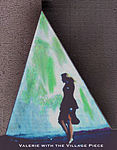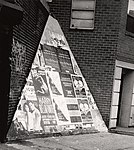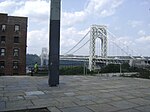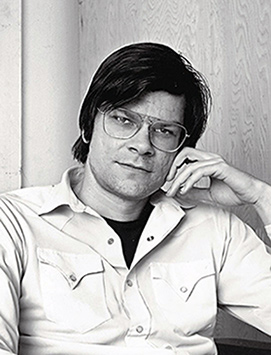
Robert Smithson was an American artist known for sculpture and land art who often used drawing and photography in relation to the spatial arts. His work has been internationally exhibited in galleries and museums and is held in public collections. He was one of the founders of the land art movement whose best known work is the Spiral Jetty (1970).
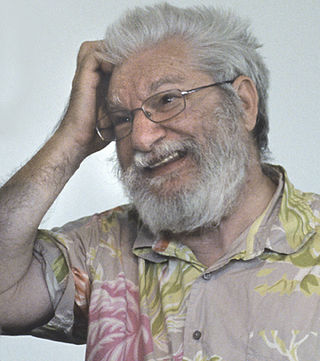
Daniel Graham was an American visual artist, writer, and curator in the writer-artist tradition. In addition to his visual works, he published a large array of critical and speculative writing that spanned the spectrum from heady art theory essays, reviews of rock music, Dwight D. Eisenhower's paintings, and Dean Martin's television show. His early magazine-based art predates, but is often associated with, conceptual art. His later work focused on cultural phenomena by incorporating photography, video, performance art, glass and mirror installation art structures, and closed-circuit television. He lived and worked in New York City.

Revs is a New York City graffiti artist whose wheat paste stickers, roller pieces, murals, sculptures, and spray-painted diary entries have earned him the reputation of an artist provocateur over the course of two decades. "Revs" is his tag name; his real name is unknown. Before adopting the tag name "Revs" he had used the tag name "Revlon;" in a 1993 New York Times interview he said he decided to shorten it to "Revs" following an epiphany he experienced after contemplating suicide on the Manhattan Bridge.

Street poster art is a kind of graffiti, more specifically categorized as "street art". Posters are usually handmade or printed graphics on thin paper. It can be understood as an art piece that is installed on the streets as opposed to in a gallery or museum, but by some it is not comprehended as a form of contemporary art.
Mel Bochner is an American conceptual artist. Bochner received his BFA in 1962 and honorary Doctor of Fine Arts in 2005 from the School of Art at Carnegie Mellon University. He lives in New York City.

Donald Joseph White, "DONDI" was an American graffiti artist.

Janet Echelman is an American sculptor and fiber artist. Her sculptures have been displayed as public art, often as site-specific installations.
Terry Alan Fox was an American Conceptual artist known for his work in performance art, video, and sound. He was of the first generation conceptual artists and he was a central participant in the West Coast performance art, video and Conceptual Art movements of the late 1960s and early 1970s. Fox was active in San Francisco and in Europe, living in Europe in the latter portion of his life.
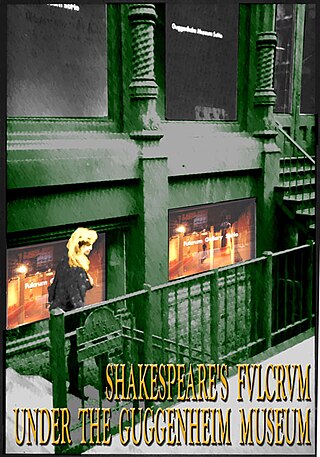
Fulcrum Gallery was an American art gallery that opened underneath the Guggenheim Museum SoHo in New York City in January 1993, by Valerie Monroe Shakespeare. It was designed by her husband, Tery Fugate-Wilcox, who contributed the gallery motto: "Without Art we are but Monkeys with Car Keys". Fugate-Wilcox is credited as photographer on all of the gallery's ads, and was listed as one of the nineteen artists represented by the gallery. The owner said in an interview, that the name "Fulcrum", came from Archimedes, "Give me a place to stand, a lever long enough and a fulcrum. and I can move the Earth". She said she hoped Fulcrum would become a "pivotal point in art history". Fulcrum Gallery was founded to exhibit Actual Art exclusively and did so until the effects of the attacks of 9/11 caused the gallery to close in February 2002.

Untitled (L's), a public sculpture by American artist David Von Schlegell, is located on the Indiana University-Purdue University Indianapolis campus, which is near downtown Indianapolis, Indiana. The sculpture is located just north of Joseph Taylor Hall in a grassy courtyard adjacent to Michigan Street. Cavanaugh hall frames the courtyard to the west, the library and Business building are east of the courtyard. This sculpture was created in 1978, and installed at IUPUI in 1980. The sculpture is a Minimalist composition of three identical steel L's. The L structures have a vertical beam that is 55 feet (17 m) tall and a horizontal beam of 45 feet (14 m). The beams themselves are 16 inches (410 mm) high and 12 inches (300 mm) wide.

J. Hood Wright Park is a park of the New York City Department of Parks and Recreation which is located between Fort Washington and Haven Avenue, and between West 173rd and 176th Streets in the Washington Heights neighborhood of Manhattan, New York City. The 6.7 acres (2.7 ha) park includes a playground – which features a model of the nearby George Washington Bridge, which is visible from the park, basketball courts, ballfields, and a recreation center, as well as a dog walk, a cave in the natural rock formations which form the park's western boundary, and an installation of a piece of modern sculpture, "3000 AD Diffussion Piece" by Terry Fugate-Wilcox.

The Three Graces is a nearly life-size, figurative Carrara marble outdoor sculpture group located on the historic Oldfields estate on the campus of the Indianapolis Museum of Art (IMA), in Indianapolis, Indiana. The neoclassical marble sculpture depicts the Three Graces, minor goddesses of the Greco-Roman pantheon. The group consists of three women frontally oriented, standing in a row upon a base. The sculpture is modeled after a c. 1797 sculpture by Antonio Canova.
Actual Art is a genre of art that was first named by critic Alfred Frankenstein of the San Francisco Chronicle in a review of Helene Aylon’s work. The name was chosen because the art was "real", but the term realism was already in use. Frankenstein described Aylon's work as a genre of art that involves “the self-conscious enlistment of the forces of nature, by artists, toward the completion of their art”. Collaboration with nature necessarily brings the dimension of time into as an integral component of the artworks, with some requiring many thousands of years for their completion. The artists consider the future of the work to be as important as its present, relinquishing control over the work to nature.

In recent years, Atlanta has become one of the USA's best cities for street art. Street artists have prominently created murals in Krog Street Tunnel, along the BeltLine, and in neighborhoods across the city. The street art conference, Living Walls, the City Speaks, originated in Atlanta in 2009.
Alex Brewer, also known as HENSE, is an American contemporary artist, best known for his dynamic, vivid and colorful abstract paintings and monumental wall pieces. He has been active since the 1990s. In 2002 he began accepting commissions for artwork and over the course of the last decade has established a solid reputation as a commissioned artist, having appeared in several solo and group shows.
eL Seed is a French-Tunisian calligraphy artist whose work features in Arabic through graffiti.

Jack Stewart was an American artist. Born in Atlanta, Georgia, he began private art lessons when he was seven. When he was about nine he went to classes at the High Museum of Art. In his early to mid-teens he apprenticed to the sculptor/painter Steffen Thomas. During WWII he served in Patton's Third Army as a combat infantryman, entering combat in the Battle of the Bulge. After the war he earned a BFA degree at Yale University, where he studied with Josef Albers and Willem de Kooning. He studied architecture at Columbia University and later earned MA and Ph.D. degrees at New York University. In 1976 Stewart married painter and art administrator Regina Serniak Stewart. His first wife and their son are deceased.
Ann Gillen is an American sculptor.
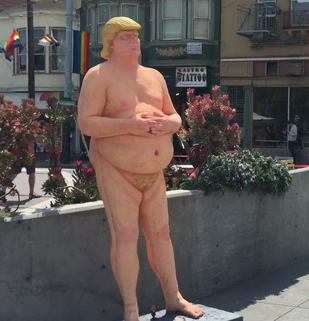
The Emperor Has No Balls is a series of sculptures depicting Donald Trump, then the Republican presidential nominee, by the activist art collective Indecline.

Barbara Cooper is an American artist whose practice encompasses abstract sculpture, public and installation art, drawing and set design. She is most known for her sculpture, which emphasizes process, handcraft, and its basis in natural forms and processes of transformation, such as growth, protection and regeneration. Critic Polly Ullrich writes that "Cooper's hand-intensive art is an art of condensation" that takes "the flow of time and growth as a subject"; that quality often leads writers to align Cooper with postminimalism. John Brunetti describes her work as "sinuous, tactile sculptures [that] quietly juxtapose conceptual and formal dichotomies, among them the organic and man-made, the feminine and the masculine, movement and stasis."


